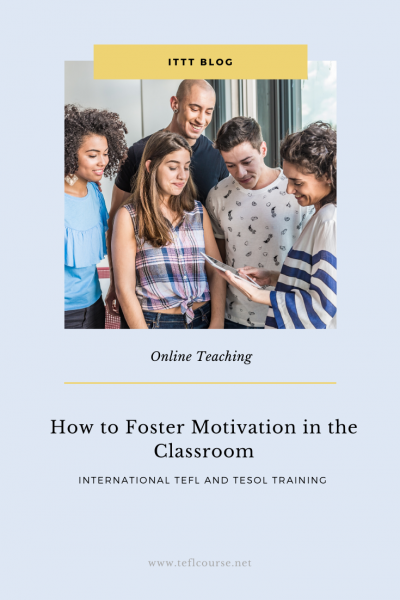How to Foster Motivation in the Classroom

A motivated student is a student who is eager to learn, and that means they are much more likely to absorb and retain what they are being taught than if they were disengaged or disinterested. This is why it is so important for teachers to foster motivation in the classroom and engage their students to be open to learning before the start of each lesson.
This post was written by our TEFL certification graduate Lindsay G. Please note that this blog post might not necessarily represent the beliefs or opinions of ITTT.
Methods
There are many different techniques teachers can use to get their students in a learning mindset. Some common and effective approaches are mental warm-ups like word games, vocal activities like singing, and physical activities like movement exercises, yoga or stretching. The most successful activation exercises, however, will likely be age and culturally appropriate, creative and engaging, thought-provoking but not too difficult (which may have the adverse effect of deterring students from trying), and curriculum or lesson-related in some way.

Also Read: "7 Great Games for Your ESL Conversation Class"
Plan Considering Students’ Age
Take for instance a group of young learners, age 6. A pre-lesson warmup activity that might engage them would be putting a bunch of pictures on the board [for instance, pictures of fruits and vegetables if lesson objectives were to learn about items located in the produce section of the grocery store] and asking them to name as many as they can and say which ones they like and don’t like.
That might be a little juvenile for teenagers or adults, though. Instead, a word game like a gap-fill exercise or a challenge to see how many different words [for example, names of different fruits and vegetables] the class can come up within 5 minutes might generate better participation and results with those age groups. Praise and Encourage
Where allowed and as appropriate, another strategy to further incentivize and motivate the class could be to reward the students with a small “prize” [for example, a pen or pencil, eraser, a 10-minute break, etc.] if they exceed their target objectives for the exercise. For instance, using the example of the class calling out names of different fruits and vegetables, if the target was to come up with 10 words and they came up with 20, they would receive a bonus for the extra effort. Incentivizing students with small “perks” can be effective for both younger and older students.

Also Read: Do I need a degree to teach English abroad?
ESA Challenge
The examples above are only a few ways to motivate students to perform. They mainly involve elicitation, which is an integral part of the ESA methodology. It challenges the students to recollect information they already know, immerses them in the language and helps the teacher gauge proficiency and interest.
If the students aren’t interested or participating, the teacher needs to recognize this and switch to a different activity or plan. (A well-prepared teacher will always have a backup plan and be resilient and adaptive, as well as in-tune with their class!) Also, teachers should use variety and not repeat the same activity over and over again, otherwise a once-fun game may turn dull and the students may lose interest.
Do you want to teach English abroad? Take a TEFL course!
No matter what approach is taken, the objective is to get the students thinking and get them in a motivated mindset to learn because once they are interested and engaged, they are much more receptive to processing new information, retaining it and using it!
Apply now & get certified to teach english abroad!
Speak with an ITTT advisor today to put together your personal plan for teaching English abroad.
Send us an email or call us toll-free at 1-800-490-0531 to speak with an ITTT advisor today.
Related Articles:
- 10 Tips for Teaching Grammar to EFL Students Abroad
- Top 10 Things To Know When Moving Abroad To Teach English
- 4 Top Tips For Getting Your TEFL Certificate on the Road
- What TEFL course is most useful?
- What’s Stopping You from Teaching English Abroad?
- The Best Countries to Teach ESL When You're 50+




